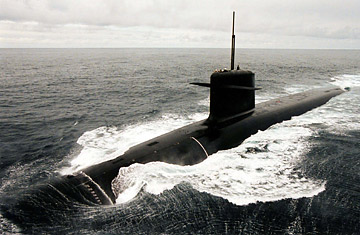
France's nuclear missile submarine, Le Triomphant
This is how a submarine-launched ballistic missile works: once airborne, the 60-ton missile travels out of the earth's atmosphere into sub-orbit, where it moves toward its target at a shade under 4 miles (6 km) a second. Approaching its destination, the tip of the missile splits into multiple, independently targeted warheads, each loaded with bombs up to 24 times more powerful than the Hiroshima blast, which re-enter the atmosphere in a spectacle that from the ground would resemble a meteor shower, before it resembled a thousand roaring suns.
There are hundreds of these and similar land-based long-range missiles ready to launch at a moment's notice. Only the original nuclear club countries have them — America, Russia, China, Britain and France. Those who justify the continued existence of these giant arsenals argue that the stability provided by such "deterrents" far outweigh the risk. The launch of one or all of these missiles — whether by design or by accident — would be a highly improbable event. (See pictures of Hiroshima.)
But not an impossible one. Sometime on Feb. 3 or 4, a British nuclear submarine carrying an estimated 50 nuclear warheads crashed into a French nuclear submarine with a similar payload in the depths of the Atlantic. When the event was leaked to a British newspaper on Feb. 16, both governments were quick to point out that there was no risk to the missiles on board. French defense minister Herve Morin called the collision an "incredible incident," and promised better communication with the British. Some commentators estimated the chance of two submarines intersecting in such a vast body of water at one in 85 million.
But to marvel at the bizarre coincidence of the collision, or to breathe a sigh of relief that nuclear safety was not breached, is to miss the point. The seemingly impossible collision of two subs in a large ocean should remind us of the fallacy by which we assume nuclear weapons will never be used. Because the threat of global nuclear war is not zero, even a small chance of war each year, multiplied over a number of years, adds up to the likelihood that the weapons will be used. Like those two subs stalking through the Atlantic, the odds will begin to align. Mathematically, they are destined to.
This is not a mere logic game. If there is a single "big idea" to have emerged in the first decade of the new millennium — from the September 11 attacks to the financial crash — it is the notion of the "black swan," the danger posed by difficult to predict, high-impact events. The short history of nuclear weapons is already scattered with unplanned and seemingly improbable incidents that suggest we feel more secure than we should. In 1995, a communication failure with the Russian Embassy led the Russian military to believe that a weather rocket launched off the coast of Norway was an incoming submarine-launched ballistic missile. In the 1980s, malfunctioning U.S. missile defense systems relayed information to U.S. officials of a massive incoming first strike — twice. As recently as 2007, a U.S. Air Force plane flew across the American heartland while unknowingly carrying several live warheads on board. At the time, all of these events were described as freak occurrences. The truth is they were freak occurrences. But they happened.(Read the Top 10 underreported stories of 2008.)
A day after the latest nuclear accident became public, an analyst from the Federation of American Scientists, a nonproliferation think tank, released U.S. Naval intelligence documents obtained through the Freedom of Information Act that showed that the Russian Navy undertook more underwater ballistic missile submarine patrols in 2008 than it has in a decade. The Russian subs are joined in the word's oceans by nuclear-armed vessels from France, Britain, and China. Under the plains of the American West, and in similar silos in Russia, Air Force missile operators keep constant vigil, launch keys at the ready. Nuclear missiles have no self-destruct button; once launched, they cannot be called back. Twenty years after the end of the cold war, humanity still lives within 30 minutes of its own destruction. The price we pay for maintaining nuclear weapons is the gamble that the highly improbable will not lead to the unthinkable. The question to ask after this latest nervy episode: is it worth it?
